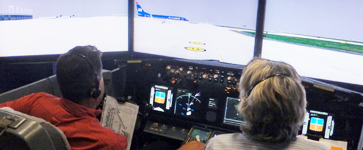 |
 |
 |
| The mission of the Human-Centered Systems Lab (HCSL) group is to improve mission safety and efficiency by developing innovative display technologies and human-centered design tools and methods. |
|
 |
| |
 |

ASIDE (ATAS-SARDA Integrated Departure Experiment) simulation completed.
An integrated flight deck and controller human-in-the-loop taxi-out operations simulation was conducted in the Dallas/Fort Worth (DFW) environment. In this first integrated Pilot-Controller Spot and Runway Departure Advisor (SARDA) simulation, ATC Ground and Local Controllers used the SARDA decision support tool to plan and issue spot release clearances and departure clearances while pilots conducted aircraft surface operations in the Airport and Terminal Area Simulator (ATAS). The objective of this simulation was to determine the stability and robustness of SARDA under realistic pilot/aircraft performance variation. This research was submitted and accepted for presentation/publication at HCI-AERO 2014, which was held in Santa Clara, CA on July 2014.
> more info
|
|
|
|
 |
 |
* Please note, there is currently no support for this website. It remains available for public access for informational/historical purposes only. *
The goal of the Human-Centered Systems Lab (HCSL) at NASA Ames Research Center is to conduct human-system interaction research supporting the aeronautics and space missions of NASA, and, during the course of that research, determine guidelines and principles of human-system interaction relevant to the effective design, efficient and safe performance, and the procedural and operational implications of such systems. Specific, noteworthy topics and efforts include:
Human-centered design. A human-centered design and evaluation process method has been employed successfully to identify system and display designs. This method integrates task analyses, technology and operational assumptions, and information requirements analysis into system requirements that then are instantiated as the defined system. A methodology for developing nominal and off-nominal scenarios allows for performance evaluation and definition/integration of procedures. A prototype tool for the tracking of system design rationales has been developed.
Human performance modeling. Multiple modeling techniques describe and predict NASA-supplied data on two aviation flight deck problems: pilot surface operations taxi errors, and approach and landing with synthetic vision systems. This 6-year aviation safety project is documented in the book "Human Performance Modeling in Aviation" (2007, Foyle & Hooey, Eds.)," in which the modeling approaches are compared, insights into the modeling process and its complexities are provided, and issues of model validation are discussed.
Flight deck surface operations (taxi). Since 1995, research studies on pilot taxi operations have determined information requirements and error conditions, and the relative contribution of specific displays for the mitigation of taxiway navigation errors. This research enabled the human-centered design of a prototype flight deck display suite for safe and efficient taxi operations (Taxiway Navigation and Situation Awareness System, T-NASA). Design principles related to local guidance, and global and route awareness have been developed.
Situation awareness with advanced avionics displays. Research has been conducted on the design of advanced avionics displays include enhanced/synthetic vision systems (E/SVS), electronic moving maps (EMMs), and head-up displays (HUDs). Guidelines and novel concepts for the design of HUD symbology (e.g., "scene-linked symbology" and fixed location symbology) to minimize attentional tunneling have been determined.
More information on the above topics is available from the "Research" and "Publications" menus at the top of this page. |
|